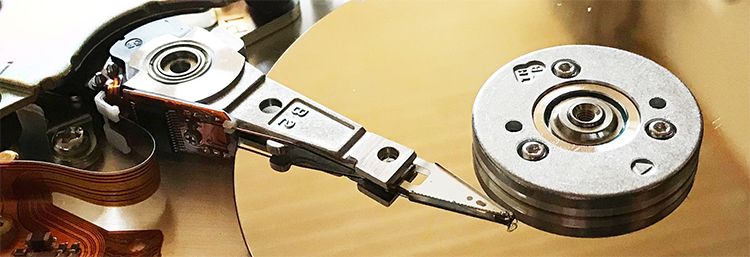DAW TECHNOLOGY: HARD DISKS.

The first commercially-available hard disk was brought to the market by IBM in 1956. It comprised of a bundle of 50 disks, each 24” wide, weighed about a ton and stored almost four megabytes (MB) of data. In theory, a few seconds of a high quality audio signal could be recorded on this machine. However computers in 1956 were not fast enough to do that. It would take until the early 1990s before the first computer-based Digital Audio Workstations (or DAWs) replaced the tape recorder, using a regular computer’s hard disk to store multichannel audio.
Hard disks have three key properties which are important for their use with audio: storage capacity, average seek time and data transfer speed.
Assuming we want to keep our audio in 24bit 44.1kHz uncompressed quality, we need about 8MB for each minute of audio that we want to store on a hard disk. So, for a live recording session of 64 continuous mono tracks over a two-hour concert, we’d need over 61 gigabytes (GB). A studio recording session perhaps wouldn’t require continuous recording of all tracks, but because smaller takes are normally done several times in the recording process, the hard disk requirements might be similar.
Storage capacity is not the only - indeed not even the most important - property of a hard disk’s performance for multi-channel audio. A hard disk comprises a magnetic surface spinning at several thousand revolutions per minute (rpm), with a read/write head hovering just above it. If we assume that in a music production process we have to be able to record and play back any combination of audio tracks, and that every single track can end up anywhere on the disk, then for every track the read/write head has to travel to the correct tangential position, or ‘cylinder’, of the spinning disk, and then wait for the correct section of the rotating cylinder to appear below the head so it can read or write the audio track.
Both of these are mechanical processes and take time - the total average is called the ‘average seek time’ of the hard disk. The IBM Hard disk from 1956 needed more than half a second but, fortunately, over the years hard disk manufacturers found many ways to improve the mechanics and lower average seek times to below 10ms for professional 7200rpm desktop hard disks in 2017.
If we would only read and write just one 24bit samples at a time, then a hard disk with a 10ms average seek time would support only 100 samples per second - not nearly enough for even a single audio track which requires at least 44100 samples to be available each second. The solution, of course, is to read and write not just one sample, but a large amount of samples each time the read/write head reaches its position for a certain track. The computer using the hard disk then stores the samples in a buffer memory, which can be accessed by a computer much faster so the tracks can be played back in perfect timing.
Data transfer speed was an issue in the 1980s, limiting the number of tracks that could be used. However, modern hard disks can have data transfer speeds of more than a gigabit per second, supporting huge channel counts. In theory you could load several seconds, minutes or even hours worth of audio data per disk access as long as there is enough buffer memory to store the batches in. The bigger the batches, the less the hard disk read/write head needs to move and the more channels can be recorded.
However, nothing is free.
The hard disk’s average seek time creates a User Interface (UI) reaction time; for all tracks to be available after placing the cursor at a position in the song and hitting “play”, all individual batches have to be loaded one by one before all tracks can start to play in sync. Many DAW’s offer a pre-load buffer to load all tracks around the cursor’s position when the system is not playing. However, the DAW system cannot predict what the operator will do next, so the next operation may have to wait until all tracks are loaded into a new buffer, each potentially coming from ‘average worst case’ locations on the hard disk, each requiring the average seek time for the hard disk to find it.
The time this takes depends on the number of tracks and the average seek time - data transfer speed of modern hard disks is so high that these can be ignored in normal conditions. With a 10ms average seek time hard disk, the system will need about a second to fill 100 channels worth of buffers, or half a second for 50, a quarter second for 25 and so on. As the number of channels to play back goes down, so does the UI reaction time.
Modern computers, even laptops, have several GB of memory available for buffering, enabling high channel counts at affordable costs using software such as Steinberg Cubase or Nuendo. For very high channel counts, multiple hard disks can be used simultaneously to speed things up, or Solid State Disks (SSDs) can be used. SSDs are more expensive compared to hard disks, but they don’t have mechanical parts and can be much faster.






